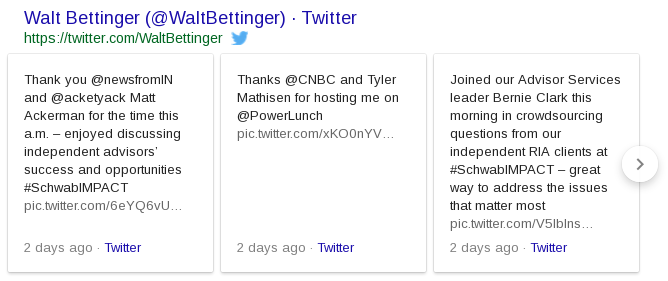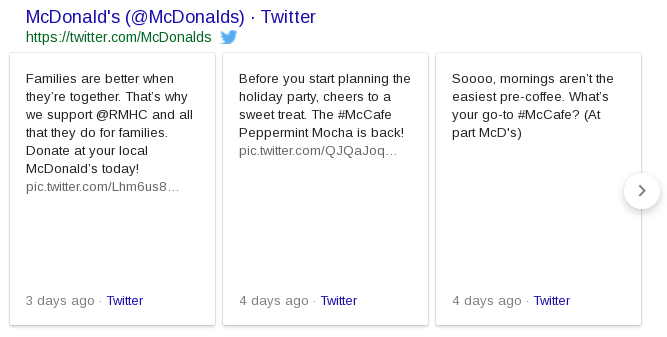How Deep is Google’s Love?: Where the In-Depth Articles have Gone (and What it Means for You)
Recently, Google appears to have made a significant change to its search results page that eliminated several in-depth articles for many clients. We’ve taken a deeper dive into this development to see what it could mean for brands and high-profile individuals, and the PR professionals who work with them.
As you know, when searching for a brand or an individual, the Google search results page presents a variety of relevant content pieces and types of media to satisfy the query. Often this means a company’s own webpage will appear at the top, followed by third-party content such as Wikipedia and news sources. There may also be social media results (if an individual or brand actively maintains these platforms), along with image results or video content.
Several years ago, Google introduced a section within top search results they called “in-depth articles”. These results looked very similar to other search results, but came from longform media outlets like Variety, Rolling Stone, or The New York Times Magazine. Often, they were a seminal article about the brand in question – articles that may have been placed by their PR teams.
Including these articles on the top results page seems to have been Google’s way of ensuring that a greater variety (and deeper) content would appear in this prime spot. Their inclusion, and the actual articles that appeared within that section, were governed by a different set of algorithms than most search results.
Recently, this section disappeared from all search pages for brands and executives. This happened without any announcement or acknowledgment on the part of Google. It is important to note that in-depth articles for many brands and individuals contained negative content. At the same time, it was the place where particularly engaging longform journalism made its way onto the prime real estate of Google page 1 for a brand.
The ramifications of Google’s elimination of this section are yet to be seen, and their motivation can only be assumed to be “less intervention” following high profile criticism of potential bias in their algorithms.
A whole host of interesting questions arise from Google’s move: What is the corporate (and civic) responsibility of those who hold the world’s data in their hands? Are there cases for intervention? Who decides what those are?
It is interesting to note that alongside this mysterious disappearance, a recent Five Blocks study of CEO search results found there are far fewer news sites (sites such as CNN, CNBC, and others) on the first couple of pages of searches for a CEO compared to a year ago. In addition, those pages feature many more profile sites, where one would find more dry facts (often created by the brand), and less news.
This marked difference in the presence of news within the organic results over the course of the past year, alongside the recent removal of the in-depth article section, means that page 1 of search for brands and individuals will contain far more“owned” content – i.e.: information they control.
For some brands this would appear to be a positive turn of events, but for many this trend means they will not automatically have great media pieces (which they often earned by being genuinely great) appear prominently in searches. It means they will need to work harder to deliberately ensure that the best third-party media does in fact place highly within their profile. Savvy communications teams will find ways to enhance their brands’ online presence within these brave new parameters.
— Sam Michelson, with Sara K. Eisen
It Pays to Be Wordy…And It’s Free!
Twitter jumped into the 2017 holiday season with something new for its 330 million users: the gift of more gab. As of early November, it officially doubled the character limit for a tweet, jumping from 140 to 280 characters.
Reactions so far are split on whether this is a good thing, with some already mourning the loss of creativity forced by the 140-character constraint. However, there is a major hidden benefit to Twitter’s new world of wordy: the way it affects your search results page.
Since August 2015, when someone Googles a term associated with a Twitter account, the search results have included a dedicated space for actual tweets from that account. That’s a win for companies, brands, and people who care about their online presence. It means their voice is right there on the search results page, in a section whose contents they completely control.

With Twitter’s newly doubled character count, we wondered if Google would come along for the ride. Would the Twitter box on the search page double in size? Or would it just cut off the tweet after 140 characters?
The answer? For Twitter boxes featuring the wordier 280-character tweets, the actual box has grown to accommodate the greater length.

This is an incredible branding gift from Twitter and Google, offering even more space in the search results for a brand (or company, or individual) to control and to tell their own story. This is the kind of space brands pay money to have on the search page.
Brands should welcome this gift with open keyboards. They have learned how to be creative in 140 characters; now it’s time to embrace the new challenge to be engaging, yet still pithy, in 280.
What’s more, companies can reap the benefits of a longer Twitter box on the search page without being needlessly wordy all the time. The box works as a carousel, allowing the searcher to scroll horizontally through a few recent tweets, beyond just the first three showing. We discovered that if any of the tweets in the box – even the ones not initially visible – are longer, it lengthens the whole box.

In this new era of Twitter 280, brands have the opportunity to offer deeper thoughts, or even just thoughts that are longer winded. That’s their choice. But now it pays to be wordy – without even having to pay.
What CMOs Need To Know About SEO
“Early in 2015 Twitter and Google struck a deal, and as a result you’re likely to see more tweets showing up in Google search results. Exactly how this will play out and how it will impact SEO remains to be seen.” Miriam Hirschman explores the possibilities in a post at Search Engine Land. “What isn’t in doubt is that being active on Twitter is more important than ever.”
How Agencies Can Help In-House SEO’s
At Five Blocks, we focus on Digital Brand Management and Reputation Management – which require a lot of the same knowledge as SEO. Clients who engage with us for Digital Brand Management often have SEO needs as well – and this is a service we offer. Interestingly, even clients who have their own SEO teams benefit from our services.
A few reasons why in-house SEO teams benefit by working with an agency.
1) When I started optimizing my first website in 2003, it was reasonable for one or two people to take on all of the responsibilities of optimization. Since then, there has been an explosion of different angles that should be addressed: Webmaster Tools, sitemaps, landing page optimization, new search engines, video optimization, etc.
2) Because we service tens of clients, we can afford to maintain a team of writers and many web assets on a variety of topics. We can provide SEO services to these clients without having to create completely new assets or hire new writers.
3) We are exposed to clients in many industries – and are challenged every day across tens of clients. As we meet each challenge, we are able to apply the lessons to additional client programs. In-house SEOs are not typically exposed to too many clients at any given time.
Taken together, it is reasonable for a company to have one or more in-house SEOs and for those SEOs to work with an external team who can help achieve measurable results by leveraging the agency’s resources, tools, and knowledge.
